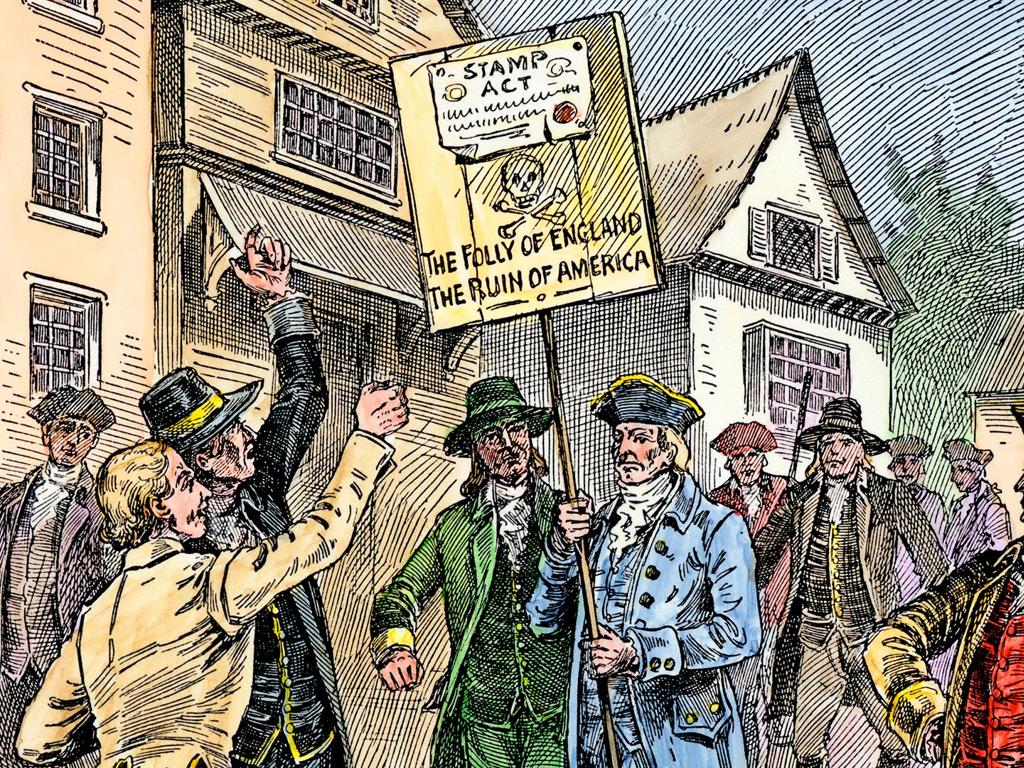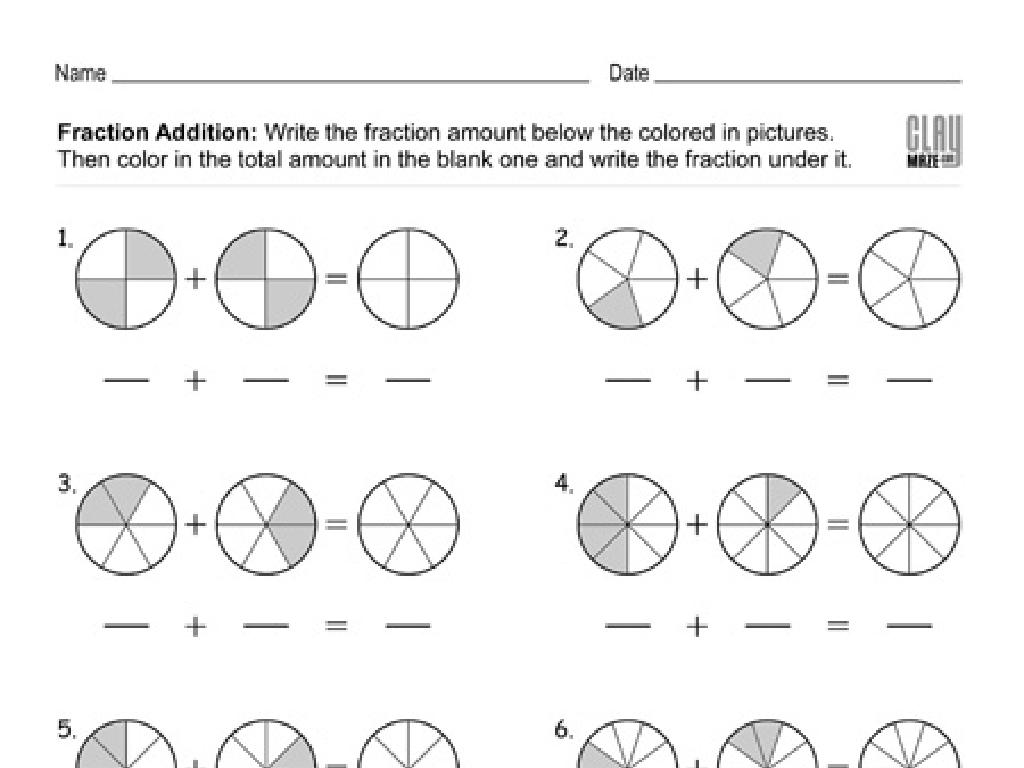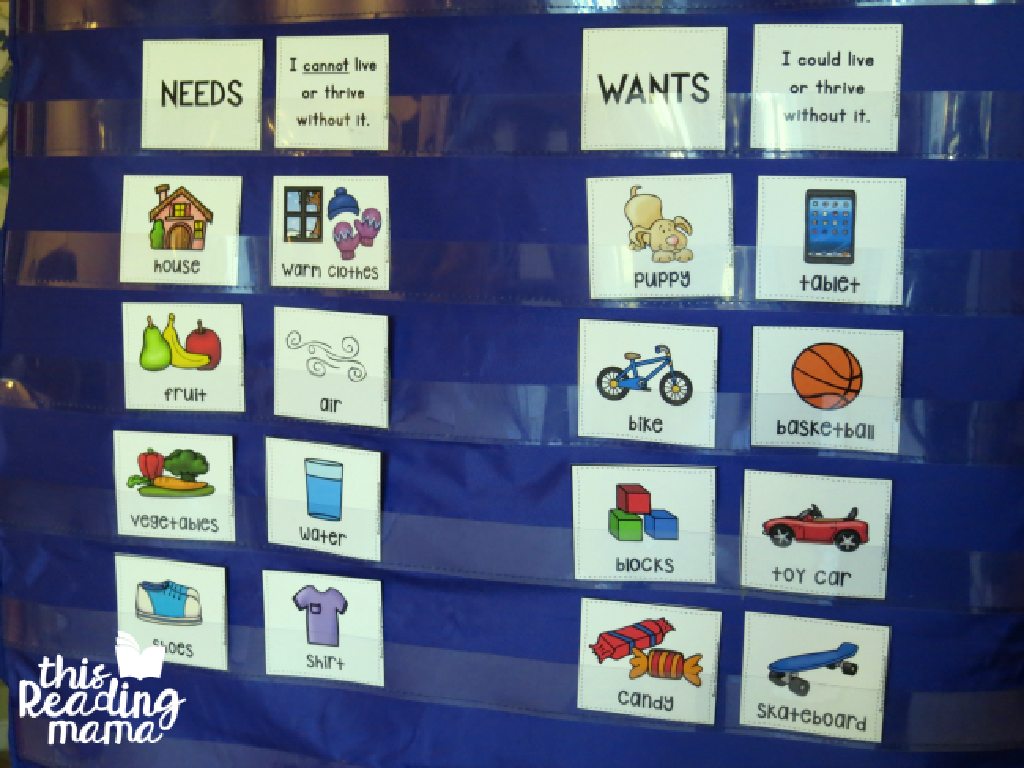Write Fractions In Lowest Terms
Subject: Math
Grade: Seventh grade
Topic: Fractions
Please LOG IN to download the presentation. Access is available to registered users only.
View More Content
Fractions: Writing in Lowest Terms
– Recap: What are fractions?
– Fractions represent parts of a whole
– Writing fractions in lowest terms
– Lowest terms: no common factors between numerator & denominator
– Importance of simplifying fractions
– Simplified fractions are easier to understand and work with
– Simplification makes comparison easier
– Simplified fractions can be compared and added more easily
|
Begin with a brief review of fractions, ensuring students recall that fractions represent parts of a whole. Explain that writing fractions in lowest terms means reducing them until the numerator and the denominator have no common factors other than 1. Emphasize the importance of simplifying fractions, as it makes them easier to understand, work with, and especially important when comparing or adding fractions. Provide examples of simplifying fractions and demonstrate how to find the greatest common divisor (GCD) to reduce fractions to their simplest form. Encourage students to practice this skill with various examples.
Fractions: Numerators and Denominators
– Review fraction components
– Numerator: parts of the whole
– The number above the fraction line
– Denominator: total equal parts
– The number below the fraction line
– Simplifying fractions
– Reducing fractions to lowest terms
|
Begin the lesson by reviewing the basic components of a fraction, ensuring that students can identify and differentiate between the numerator and the denominator. The numerator, located at the top of the fraction, indicates how many parts of the whole are being considered, while the denominator, at the bottom, represents the total number of equal parts that make up the whole. After the review, introduce the concept of simplifying fractions to their lowest terms by finding the greatest common divisor (GCD) of the numerator and the denominator and dividing both by this number. Provide examples and practice problems to reinforce the concept.
Simplifying Fractions Using GCF
– Define Greatest Common Factor (GCF)
– GCF is the highest number that divides both numbers without a remainder.
– Find GCF for numerator & denominator
– Use prime factorization or Euclidean algorithm to find GCF.
– GCF simplification examples
– Example: For 8/12, GCF of 8 and 12 is 4. Simplified form is 2/3.
– Practice simplifying fractions
|
This slide introduces the concept of the Greatest Common Factor (GCF) and its role in simplifying fractions. Begin by defining GCF and explaining that it’s the largest number that can divide both the numerator and denominator without leaving a remainder. Demonstrate finding the GCF through methods like prime factorization or the Euclidean algorithm. Provide examples to show how to use the GCF to simplify fractions to their lowest terms. For instance, with the fraction 8/12, the GCF of 8 and 12 is 4, so dividing both by 4 gives the simplified fraction 2/3. Conclude with practice problems for students to apply their understanding of GCF in simplifying fractions.
Simplifying Fractions: Step-by-Step
– Divide by the Greatest Common Factor (GCF)
– Find GCF of numerator & denominator, then divide both by it
– Check if further simplification is possible
– After dividing, see if the fraction can be reduced more
– Practice with a class example
– Example: Simplify 16/24 together
|
Begin by explaining the concept of the Greatest Common Factor (GCF) and how it is used to simplify fractions. Demonstrate the process of finding the GCF of the numerator and denominator and then dividing both by this number to simplify the fraction. Emphasize the importance of checking if the fraction can be simplified further, which ensures it is in its lowest terms. Engage the class with a hands-on example, such as simplifying the fraction 16/24, and walk through each step together. Encourage students to ask questions and try simplifying additional fractions for practice. Provide guidance and support as needed, and consider offering extra examples for students who grasp the concept quickly.
Practice: Simplifying Fractions
– Work through examples together
– Students simplify fractions individually
– Use fractions like 4/8 or 6/9 to practice reducing to lowest terms
– Discuss solutions collectively
– Compare answers and methods used to simplify
– Reinforce learning through practice
|
This slide is designed to engage students in active learning by first demonstrating the process of simplifying fractions, then allowing them to practice the skill independently. Afterward, open a class discussion to go over the solutions. This collaborative approach helps students learn from each other and clarifies any misunderstandings. As a teacher, facilitate the discussion by asking guiding questions and offering multiple examples. Possible activities: 1) Pair students to solve problems, 2) Create a game where students race to simplify fractions, 3) Use fraction strips for visual learners, 4) Have students create their own problems to challenge classmates.
Common Mistakes in Simplifying Fractions
– Incorrect Greatest Common Factor (GCF)
– Ensure you find the largest number that divides both numerator and denominator.
– Incomplete simplification
– Always double-check if the fraction can be reduced further.
– Tips for accurate simplification
– Cross-check with multiplication to verify the GCF is correct.
– Practice problems for mastery
|
When teaching students to write fractions in lowest terms, it’s crucial to highlight common errors and provide strategies for avoiding them. Emphasize the importance of correctly identifying the greatest common factor (GCF) as this is the key to simplifying fractions. Remind students that simplification isn’t complete until the fraction cannot be reduced any further. Offer tips such as checking their work by multiplying the factors to ensure they have the correct GCF. Encourage regular practice with a variety of problems to help students become proficient in simplifying fractions and to reinforce the concept of finding the lowest terms.
Real-World Applications of Simplifying Fractions
– Importance of simplifying fractions
– Cooking: Measuring ingredients
– Use 1/2 cup instead of 2/4 cups for a recipe
– Building: Calculating materials
– Determine the right amount of wood using 3/9 of a foot
– Shopping: Comparing prices
– Find the best deal by simplifying fractions on price tags
|
This slide aims to show students how simplifying fractions is not just a mathematical exercise but a practical skill used in everyday life. In cooking, simplified fractions make measuring ingredients quicker and easier. In building, it helps in accurately calculating materials needed, avoiding waste. While shopping, simplifying fractions can help compare prices and get the best value for money. Encourage students to think of other areas where simplifying fractions could be applied and discuss the importance of efficiency and accuracy that this skill brings to various tasks.
Class Activity: Fraction Scavenger Hunt
– Find classroom objects as fractions
– Write & simplify these fractions
– For example, if 2 out of 4 parts of an object are colored, write 2/4 and simplify to 1/2
– Share findings with the class
– Reflect on the activity
– Discuss what you learned about simplifying fractions
|
This interactive activity is designed to help students identify fractions in everyday objects and practice simplifying them. Students will search the classroom for items that can be represented as fractions, such as a group of pencils where some are red and others are blue. They will then write down these fractions and work on simplifying them to their lowest terms. Afterward, students will share their findings with the class, fostering a collaborative learning environment. As a teacher, prepare to guide them through the simplification process and provide assistance as needed. Possible activities include finding fractions in window panes, book arrangements, or portions of a clock. Encourage students to explain their thought process during the sharing session to reinforce their understanding.
Conclusion: Mastering Lowest Terms
– Recap on simplifying fractions
– Review the steps to write fractions in their simplest form
– Practice makes perfect
– Consistent practice is key to understanding
– Homework for reinforcement
– Solve assigned problems to improve skills
– Importance of lowest terms
– Simplified fractions are easier to compare and work with
|
As we conclude today’s lesson on writing fractions in lowest terms, it’s crucial to emphasize the importance of practice in mastering this concept. Simplifying fractions is a fundamental skill in math that aids in better understanding and solving more complex problems. For homework, students will be given a set of problems to reinforce their learning. Encourage them to approach each problem methodically, using the greatest common divisor to reduce fractions to their simplest form. Remind them that being able to write fractions in lowest terms is not only essential for their math proficiency but also for real-life applications, such as cooking or dividing resources.





